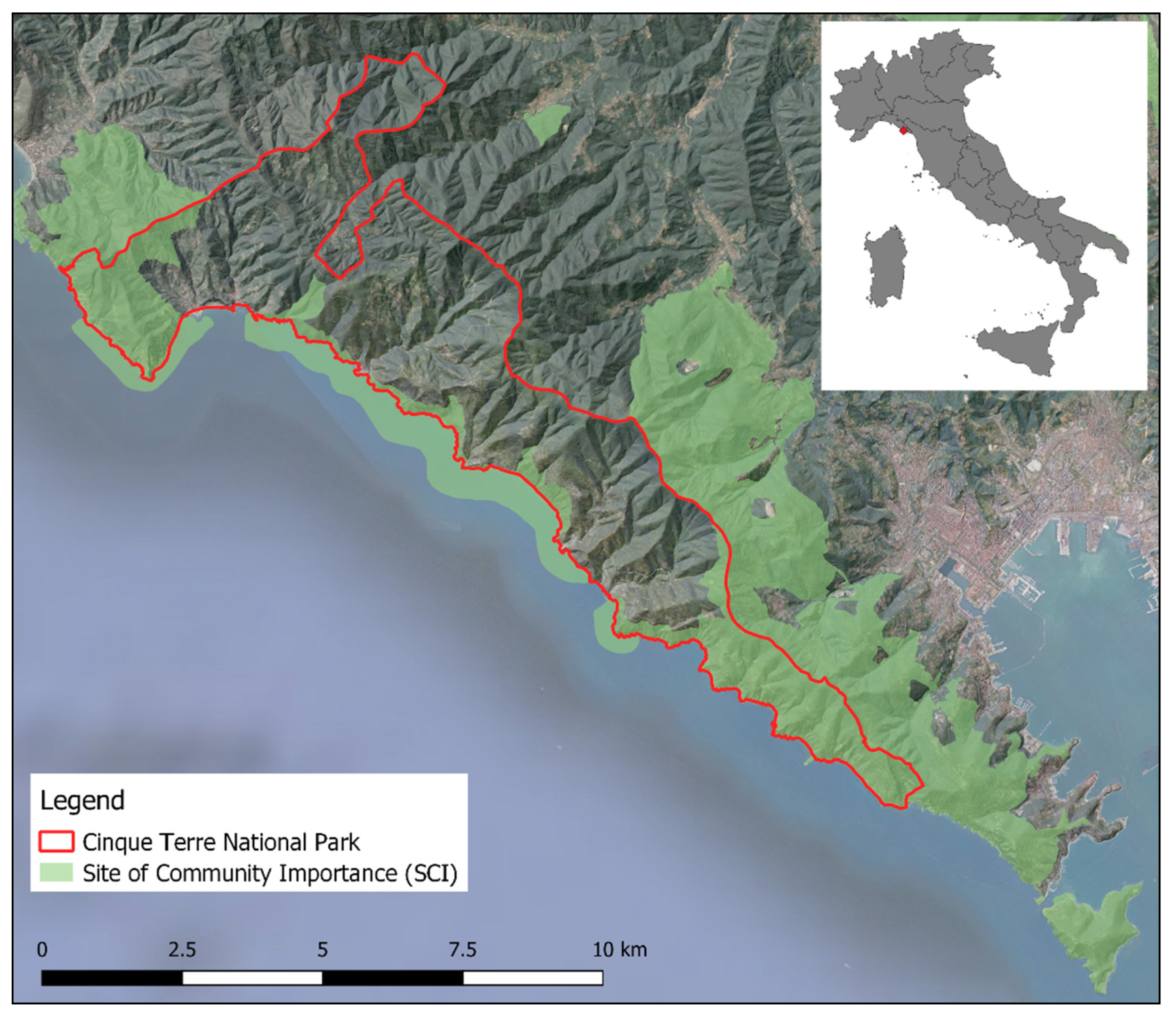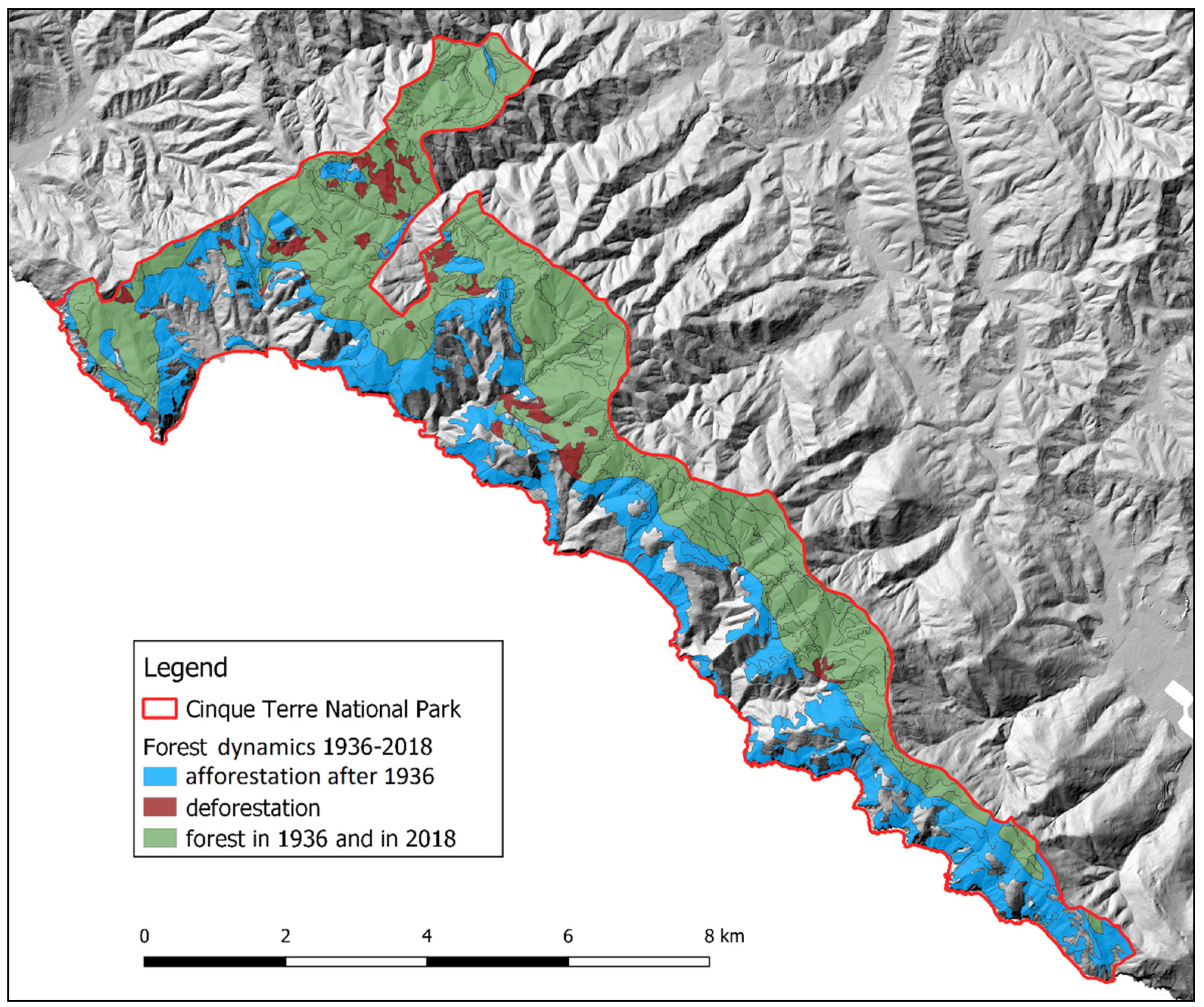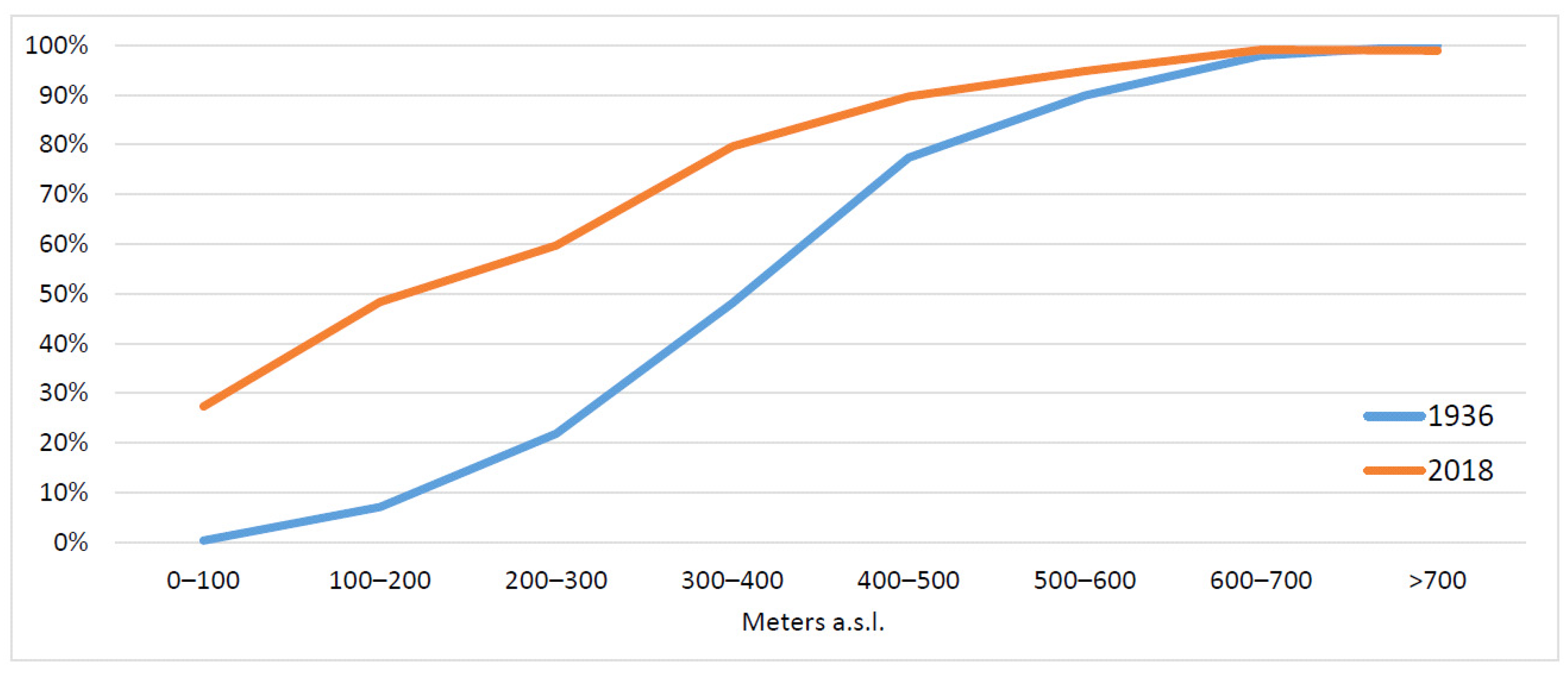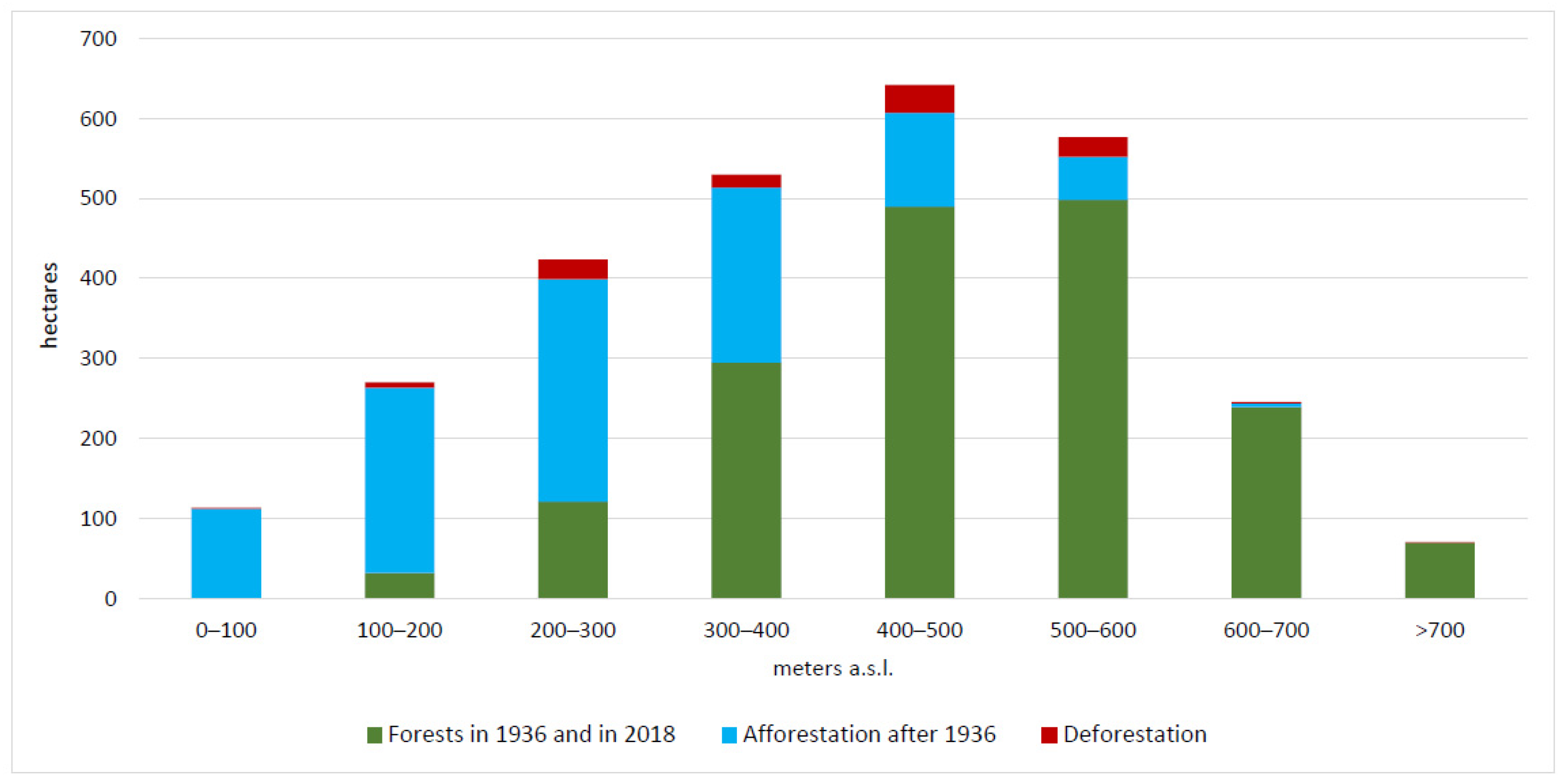Forest Area Changes in Cinque Terre National Park in the Last 80 Years. Consequences on Landslides and Forest Fire Risks
Abstract
1. Introduction
2. Materials and Methods
2.1. The Study Area
2.2. Methodology
- Woodlands present in 1936: All the forest areas of 2018 that were already covered by woods in 1936;
- Woodlands of new growth: All the forest areas of 2018 that in 1936 were designed for other uses, such as agriculture and pastures and; therefore, corresponds to the territories in which forests expanded in the period 1936–2018;
- Lost woodlands: All the non-forest areas of 2018 that in 1936 were instead covered by forests, corresponding to the areas from which forests have been removed.
3. Results
3.1. The Transformation of the Forested Areas in the Period 1936–2018
3.2. Forest Fires and Hydrogeological Risk in Cinque Terre National Park
3.3. The Role of the National Park and of the Sites of Community Importance
- 91AA—Eastern white oak woods
- 91E0—Alluvial forests with Alnus glutinosa and Fraxinus excelsior (Alno-Padion, Alnion incanae, Salicion albae)
- 9260—Castanea sativa woods
- 9330—Quercus suber forests
- 9340—Quercus ilex and Quercus rotundifolia forests
- 9540—Mediterranean pine forests with endemic Mesogean pines
4. Discussion
5. Conclusions
Author Contributions
Funding
Data Availability Statement
Conflicts of Interest
References
- Vos, W.; Meekes, H. Trends in European cultural landscape development: Perspectives for a sustainable future. Landsc. Urban Plan. 1999, 46, 3–14. [Google Scholar] [CrossRef]
- Plieninger, T.; Draux, H.; Fagerholm, N.; Bieling, C.; Bürgi, M.; Kizos, T.; Verburg, P.H. The driving forces of landscape change in Europe: A systematic review of the evidence. Land Use Policy 2016, 57, 204–214. [Google Scholar] [CrossRef]
- García-Martín, M.; Quintas-Soriano, C.; Torralba, M.; Wolpert, F.; Plieninger, T. Landscape Change in Europe. In Sustainable Land Management in a European Context. Co-Design Approach; Weith, T., Barkmann, T., Gaasch, N., Rogga, S., Strauß, C., Zscheischler, J., Eds.; Springer: Cham, Switzerland, 2020; pp. 17–37. [Google Scholar]
- Jongman, R.H.G. Homogenisation and fragmentation of the European landscape: Ecological consequences and solutions. Landsc. Urban Plan. 2002, 58, 211–221. [Google Scholar] [CrossRef]
- Palang, H.; Mander, U.; Aarne, L. Landscape diversity changes in Estonia. Landsc. Urban Plan. 1998, 41, 163–169. [Google Scholar] [CrossRef]
- Kizos, T.; Koulouri, M. Agricultural landscape dynamics in the Mediterranean: Lesvos (Greece) case study using evidence from the last three centuries. Environ. Sci. Policy 2006, 9, 330–342. [Google Scholar] [CrossRef]
- Wolpert, F.; Quintas-Soriano, C.; Plieninger, T. Exploring land-use histories of tree-crop landscapes: A cross-site comparison in the Mediterranean Basin. Sustain. Sci. 2020, 15, 1267–1283. [Google Scholar] [CrossRef]
- Debolini, M.; Marraccini, E.; Dubeuf, J.P.; Geijzendorffer, I.R.; Guerra, C.; Simon, M.; Targetti, S.; Napoléone, C. Land and farming system dynamics and their drivers in the Mediterranean Basin. Land Use Policy 2018, 75, 702–710. [Google Scholar] [CrossRef]
- Loran, C.; Munteanu, C.; Verburg, P.H.; Schmatz, D.R.; Bürgi, M.; Zimmermann, N.E. Long-term change in drivers of forest cover expansion: An analysis for Switzerland (1850–2000). Reg. Environ. Chang. 2017, 17, 2223–2235. [Google Scholar] [CrossRef]
- Agnoletti, M.; Santoro, A. Cultural values and sustainable forest management: The case of Europe. J. For. Res. 2015, 20, 438–444. [Google Scholar] [CrossRef]
- Senf, C.; Seidl, R. Mapping the forest disturbance regimes of Europe. Nat. Sustain. 2021, 4, 63–70. [Google Scholar] [CrossRef]
- Fuchs, R.; Herold, M.; Verburg, P.H.; Clevers, J.G.P.W.; Eberle, J. Gross changes in reconstructions of historic land cover/use for Europe between 1900 and 2010. Glob. Chang. Biol. 2015, 21, 299–313. [Google Scholar] [CrossRef]
- Krajewski, P.; Solecka, I.; Mrozik, K. Forest landscape change and preliminary study on its driving forces in Ślęża Landscape Park (Southwestern Poland) in 1883–2013. Sustainability 2018, 10, 4526. [Google Scholar] [CrossRef]
- Gellrich, M.; Baur, P.; Koch, B.; Zimmermann, N.E. Agricultural land abandonment and natural forest re-growth in the Swiss mountains: A spatially explicit economic analysis. Agric. Ecosyst. Environ. 2007, 118, 93–108. [Google Scholar] [CrossRef]
- Palmero-Iniesta, M.; Espelta, J.M.; Gordillo, J.; Pino, J. Changes in forest landscape patterns resulting from recent afforestation in Europe (1990–2012): Defragmentation of pre-existing forest versus new patch proliferation. Ann. For. Sci. 2020, 77, 1–15. [Google Scholar] [CrossRef]
- Bebi, P.; Seidl, R.; Motta, R.; Fuhr, M.; Firm, D.; Krumm, F.; Kulakowski, D. Changes of forest cover and disturbance regimes in the mountain forests of the Alps. For. Ecol. Manag. 2017, 388, 43–56. [Google Scholar] [CrossRef] [PubMed]
- Camarretta, N.; Puletti, N.; Chiavetta, U.; Corona, P. Quantitative changes of forest landscapes over the last century across Italy. Plant Biosyst. Int. J. Deal. Asp. Plant Biol. 2018, 152, 1011–1019. [Google Scholar] [CrossRef]
- Decreto del Presidente della Repubblica. Istituzione del Parco Nazionale delle Cinque Terre. Gazzetta Ufficiale della Repubblica Italiana del 17.12.1999. Available online: https://www.gazzettaufficiale.it/atto/serie_generale/caricaDettaglioAtto/originario?atto.dataPubblicazioneGazzetta=1999-12-17&atto.codiceRedazionale=99A10702&elenco30giorni=false (accessed on 9 March 2021).
- Ente Parco Nazionale delle Cinque Terre. Statuto del Parco Nazionale delle Cinque Terre. Approvato con Deliberazione n. 042 del 08.06.2011. Available online: www.parconazionale5terre.it/pdf/DeliberaStatuto42_2011.pdf (accessed on 22 January 2021).
- ISTAT. Censimento Generale dell’Agricoltura 2010; ISTAT: Rome, Italy, 2010. [Google Scholar]
- Istituto Centrale di Statistica del Regno d’Italia. Catasto Agrario 1929; Istituto Poligrafico dello Stato: Rome, Italy, 1934. [Google Scholar]
- Cerda, A.; Rodrigo-Comino, J.; Novara, A.; Brevik, E.C.; Vaezi, A.R.; Pulido, M.; Giménez-Morera, A.; Keesstra, S.D. Long-term impact of rainfed agricultural land abandonment on soil erosion in the Western Mediterranean basin. Prog. Phys. Geogr. Earth Environ. 2018, 42, 202–219. [Google Scholar] [CrossRef]
- Brancucci, G.; Masetti, M. Terraced Systems: Heritage and Risk. In Terraced Landscapes of the Alps: Atlas; Scaramellini, G., Varotto, M., Eds.; Marsilio: Venice, Italy, 2008; pp. 46–53. [Google Scholar]
- Harden, C. Interrelationships between abandonment and land degradation: A case from the Ecuadorian Andes. Mt. Res. Dev. 1996, 16, 274–280. [Google Scholar] [CrossRef]
- Lasanta, T.; García-Ruiz, J.M.; Pérez Rontomé, M.C.; Sancho, C. Runoff and sediment yield in a semi-arid environment: The effect of land management after farmland abandonment. Catena 2000, 38, 265–278. [Google Scholar] [CrossRef]
- Khanal, N.; Watanabe, T. Abandonment of agricultural land and its consequences. Mt. Res. Dev. 2006, 26, 32–40. [Google Scholar] [CrossRef]
- Sanchez-Maranon, M.; Soriano, M.; Delgado, G.; Delgado, R. Soil quality in Mediterranean mountain environments. Effects of land use change. Soil Sci. Soc. Am. J. 2002, 66, 948–958. [Google Scholar]
- Compagnoni, C. Biblioteca Storica di Diodoro Siculo Tomo Secondo; Tipografia di Gian Battista Sonzogno: Milan, Italy, 1820. [Google Scholar]
- Marmocchi, F.C. Descrizione dell’Italia; Poligrafica Italiana: Florence, Italy, 1846. [Google Scholar]
- Terranova, R. Il Paesaggio Costiero Terrazzato delle Cinque Terre in Liguria. Studi Ric. Geogr. 1989, XII, 1–58. [Google Scholar]
- UNESCO. Advisory Board Evaluation; UNESCO: Paris, France, 1998. [Google Scholar]
- Kottek, M.; Grieser, J.; Beck, C.; Rudolf, B.; Rubel, F. World Map of the Köppen-Geiger climate classification updated. Meteorol Z 2006, 15, 259–263. [Google Scholar] [CrossRef]
- Terranova, R.; Zanzucchi, G.; Bernini, M.; Brandolini, P.; Campobasso, S.; Faccini, F.; Zanzucchi, F. Geologia, geomorfologia e vini del parco Nazionale delle Cinque Terre (Liguria, Italia). Boll. Soc. Geol. Ital. Spec. 2006, 6, 115–128. [Google Scholar]
- Puddu, G. Le Trasformazioni del Paesaggio Viste Attraverso la Cartografia Storica: Il Caso Della Regione Sardegna; Università Degli Studi Della Tuscia: Viterbo, Italy, 2010. [Google Scholar]
- Turcato, C.; Paoli, C.; Scopesi, C.; Montagnani, C.; Mariotti, M.G.; Vassallo, P. Matsucoccus bast scale in Pinus pinaster forests: A comparison of two systems by means of emergy analysis. J. Clean. Prod. 2015, 96, 539–548. [Google Scholar] [CrossRef]
- Parco Nazionale delle Cinque Terre. Piano di Previsione, Prevenzione e Lotta Attiva Contro Gli Incendi Boschivi. Periodo 2015–2019. Ministero dell’Ambiente e della Tutela del Territorio e del Mare. Available online: www.minambiente.it/sites/default/files/archivio/allegati/aib/paib_2015_19_pn_cinque_terre.pdf (accessed on 26 January 2021).
- Adams, W. Future Nature: A Vsion for Conservation; Earthscan: London, UK, 2003. [Google Scholar]
- Rotherham, I.D. The call of the wild: Perceptions, history people & ecology in the emerging paradigms of wilding. ECOS 2014, 35, 35–43. [Google Scholar]
- Bobiec, A.; Paderewski, J.; Gajdek, A. Urbanisation and globalised environmental discourse do not help to protect the bio-cultural legacy of rural landscapes. Landsc. Urban Plan. 2021, 208, 104038. [Google Scholar] [CrossRef]
- D’Amato Avanzi, G.; Galanti, Y.; Giannecchini, R.; Mazzali, A.; Saulle, G. Remarks on the 25 October 2011 rainstorm in East-ern Liguria and Northwestern Tuscany (Italy) and the related landslides. Rend. Online Soc. Geol. Ital. 2013, 24, 76–78. [Google Scholar]
- Agnoletti, M.; Errico, A.; Santoro, A.; Dani, A.; Preti, F. Terraced landscapes and hydrogeological risk. The effects of land abandonment in Cinque Terre (Italy) during severe rainfall events. Sustainability 2019, 11, 235. [Google Scholar] [CrossRef]
- Brandolini, P.; Cevasco, A.; Capolongo, D.; Pepe, G.; Lovergine, F.; Del Monte, M. Response of terraced slopes to a very in-tense rainfall event and relationships with land abandonment: A case study from Cinque Terre (Italy). Land Degrad. Dev. 2018, 29, 630–642. [Google Scholar] [CrossRef]
- European Commission. Evaluation Support Study on the Impact of the CAP on Sustainable Management of the Soil. Final Report; Report Number: KF-02-20-617-EN-N; 2020; Available online: https://op.europa.eu/en/publication-detail/-/publication/85bd465d-669b-11eb-aeb5-01aa75ed71a1/language-en (accessed on 19 February 2021). [CrossRef]
- Carlucci, M.; Zambon, I.; Colantoni, A.; Salvati, L. Socioeconomic Development, Demographic Dynamics and Forest Fires in Italy, 1961–2017: A Time-Series Analysis. Sustainability 2019, 11, 1305. [Google Scholar] [CrossRef]
- Elmarsdottir, A.; Fjellberg, A.; Halldorsson, G.; Ingimarsdottir, M.; Nielsen, O.K.; Nygaard, P.; Sigurdsson, B.D. Effects of afforestation on biodiversity. AFFORNORD. Effects of afforestation on ecosystems, landscape and rural development. TemaNord 2008, 562, 37–47. [Google Scholar]
- Clergeau, P.; Fourcy, D. Effects of landscape homogeneity on starling roost distribution. Agric. Ecosyst. Environ. 2005, 110, 300–306. [Google Scholar] [CrossRef]
- Tavares, P.D.; Uzêda, M.C.; Pires, A.D.S. Biodiversity conservation in agricultural landscapes: The importance of the matrix. Floresta e Ambient. 2019, 26, 26. [Google Scholar] [CrossRef]
- Santoro, A.; Venturi, M.; Agnoletti, M. Landscape perception and public participation for the conservation and valorization of cultural landscapes. The case of the Cinque Terre and Porto Venere UNESCO Site. Land 2021, 10, 93. [Google Scholar] [CrossRef]
- Petit, C.C.; Lambin, E.F. Impact of data integration technique on historical land-use/land-cover change: Comparing historical maps with remote sensing data in the Belgian Ardennes. Landsc. Ecol. 2002, 17, 117–132. [Google Scholar] [CrossRef]
- Ales, R.F.; Martin, A.; Ortega, F.; Ales, E.E. Recent changes in landscape structure and function in a Mediterranean region of SW Spain (1950–1984). Landsc. Ecol. 1992, 7, 3–18. [Google Scholar] [CrossRef]
- Debussche, M.; Lepart, J.; Dervieux, A. Mediterranean landscape changes: Evidence from old postcards. Glob. Ecol. Biogeogr. 1999, 8, 3–15. [Google Scholar] [CrossRef]
- MacDonald, D.; Crabtree, J.R.; Wiesinger, G.; Dax, T.; Stamou, N.; Fleury, P.; Gutierrex Lazpita, J.; Gibon, A. Agriculture abandonment in mountain areas of Europe: Environmental consequences and policy response. J. Environ. Manag. 2000, 59, 47–69. [Google Scholar] [CrossRef]
- Ojima, D.S.; Galvin, K.A.; Turner, B.L. The global impact of land-use change. Bioscience 1994, 44, 300–305. [Google Scholar] [CrossRef]
- Falcucci, A.; Maiorano, L.; Boitani, L. Changes in land-use/land-cover patterns in Italy and their implications for biodiversity conservation. Landsc. Ecol. 2007, 22, 617–631. [Google Scholar] [CrossRef]
- Malandra, F.; Vitali, A.; Urbinati, C.; Garbarino, M. 70 years of land use/land cover changes in the Apennines (Italy): A meta-analysis. Forests 2018, 9, 551. [Google Scholar] [CrossRef]
- Agnoletti, M. The degradation of traditional landscape in a mountain area of Tuscany during the 19th and 20th centuries: Implications for biodiversity and sustainable management. For. Ecol. Manag. 2007, 249, 5–17. [Google Scholar] [CrossRef]
- Van Gils, H.; Batsukh, O.; Rossiter, D.; Munthali, W.; Liberatoscioli, E. Forecasting the pattern and pace of Fagus forest expansion in Majella National Park, Italy. Appl. Veg. Sci. 2008, 11, 539–546. [Google Scholar] [CrossRef]
- Piovesan, G.; Di Filippo, A.; Alessandrini, A.; Biondi, F.; Schirone, B. Structure, dynamics and dendroecology of an old-growth Fagus forest in the Apennines. J. Veg. Sci. 2005, 16, 13–28. [Google Scholar] [CrossRef]
- Vazzano, E.; Quilghini, G.; Travaglini, D.; Nocentini, S. Changes in forest cover in the Foresta della Lama (Casentino Forests National Park) from Karl Siemon’s and Anton Seeland’s 1837 forest management plan. For. J. Silvic. For. Ecol. 2011, 8, 78–87. [Google Scholar] [CrossRef]
- Palombo, C.; Chirici, G.; Marchetti, M.; Tognetti, R. Is land abandonment affecting forest dynamics at high elevation in Mediterranean mountains more than climate change? Plant Biosyst. Int. J. Deal. Asp. Plant Biol. 2013, 147, 1–11. [Google Scholar] [CrossRef]
- Oikonomakis, N.G.; Ganatsas, P. Secondary forest succession in Silver birch (Betula pendula Roth) and Scots pine (Pinus sylvestris L.) southern limits in Europe, in a site of Natura 2000 network—An ecogeographical approach. For. Syst. 2020, 29, 81–96. [Google Scholar] [CrossRef]
- Morales-Molino, C.; Colombaroli, D.; Valbuena-Carabaña, M.; Tinner, W.; Salomón, R.L.; Carrión, J.S.; Gil, L. Land-use history as a major driver for long-term forest dynamics in the Sierra de Guadarrama National Park (central Spain) during the last millennia: Implications for forest conservation and management. Glob. Planet. Chang. 2017, 152, 64–75. [Google Scholar] [CrossRef]
- MCPFE. Vienna Resolution 3. In Proceedings of the Expert Level Meeting of the Ministerial Conference for the Protection of Forests in Europe, Warsaw, Poland, 14–15 October 2004. [Google Scholar]




| Forest Typologies 1936 | Forest Typologies 2018 |
|---|---|
| Pine forests | Pine forests |
| Degraded woods | Sclerophyll vegetation-Mediterranean maquis |
| shrublands | |
| Forests and shrubland in evolution | |
| Chestnut forest—Coppice | Forest with prevalence of chestnuts |
| Chestnut forest—High stand | |
| Mixed broadleaved coppice forests | Mixed broadleaved forest |
| Xerophilous forest with evergreen vegetation | |
| Hygrophilous forest | |
| Mixed forests conifer and broadleaved |
| Forests in 1936 | Area (ha) | Area (%) |
|---|---|---|
| Pine forests | 1345.2 | 72.43 |
| Mixed broadleaved coppice forests | 244.25 | 13.15 |
| Chestnut forest—Coppice | 161.56 | 8.70 |
| Chestnut forest—High stand | 68.09 | 3.67 |
| Degraded woods | 38.22 | 2.06 |
| Total | 1857.32 | 100.00 |
| Forests in 2018 | Area (ha) | Area (%) |
|---|---|---|
| Pine forests | 1204.58 | 43.59 |
| Sclerophyll vegetation-Mediterranean maquis | 383.91 | 13.89 |
| Forest with prevalence of chestnuts | 341.88 | 12.37 |
| Mixed forests conifer and broadleaved | 324.40 | 11.74 |
| Xerophilous forest with evergreen vegetation | 279.45 | 10.11 |
| Mixed broadleaved forest | 116.85 | 4.23 |
| Forests and shrubland in evolution | 45.33 | 1.64 |
| Hygrophilous forest | 33.73 | 1.22 |
| Shrublands | 33.37 | 1.21 |
| Total | 2763.50 | 100.00 |
| 2018 | |||||||||||
|---|---|---|---|---|---|---|---|---|---|---|---|
| Forest with Prevalence of Chestnuts | Forests and Shrubland in Evolution | Hygrophilous Forest | Mixed Broadleaved Forest | Mixed Forests Conifer and Broadleaved | Pine Forests | Sclerophyll Vegetation-Mediterranean Maquis | Shrublands | Xerophilous Forest with Evergreen Vegetation | Not Forest | ||
| 1936 | Chestnut Forest—Coppice | 66.3 | 3.0 | 6.9 | - | 30.7 | 41.3 | 1.0 | - | 0.7 | 11.7 |
| Chestnut Forest—High Stand | 33.4 | - | 4.3 | - | 22.2 | 8.2 | - | - | - | - | |
| Degraded Woods | 20.0 | - | - | - | 6.3 | 12.0 | - | - | - | - | |
| Mixed Broadleaved Coppice Forests | 73.9 | - | - | 10.0 | 38.7 | 90.9 | 5.6 | - | 20.2 | 5.0 | |
| Pine Forests | 128.3 | 3.7 | 16.1 | 83.2 | 145.3 | 678.7 | 56.8 | 18,2 | 120.8 | 94.0 | |
| Not Forest | 20.1 | 38.6 | 6.4 | 23.6 | 81.2 | 373.6 | 320.5 | 15,1 | 137.7 | 986.7 | |
| FOREST FIRE RISK CLASS | ||||||
|---|---|---|---|---|---|---|
| Forest Area Changes 1936–2018 | Area (ha) | No Risk | 1 | 2 | 3 | 4 |
| Forest in 1936 and in 2018 | 1747.25 | 1.7% | 14.9% | 48.9% | 33.7% | 0.7% |
| Afforestation after 1936 | 1022.61 | 0.7% | 23.2% | 38.4% | 37.6% | 0.2% |
| Deforestation | 110.61 | 0.6% | 28.5% | 41.5% | 29.3% | 0.0% |
| LANDSLIDE RISK CLASS | ||||||
| Forest Area Changes 1936–2018 | Area (ha) | No Risk | Moderate | Medium | High | Very High |
| Forest in 1936 and in 2018 | 1747.25 | 95.3% | 3.6% | 1.1% | 0.0% | 0.0% |
| Afforestation after 1936 | 1022.61 | 68.7% | 20.3% | 4.3% | 4.3% | 2.2% |
| Deforestation | 110.61 | 54.7% | 31.2% | 14.0% | 0.0% | 0.0% |
Publisher’s Note: MDPI stays neutral with regard to jurisdictional claims in published maps and institutional affiliations. |
© 2021 by the authors. Licensee MDPI, Basel, Switzerland. This article is an open access article distributed under the terms and conditions of the Creative Commons Attribution (CC BY) license (http://creativecommons.org/licenses/by/4.0/).
Share and Cite
Santoro, A.; Venturi, M.; Piras, F.; Fiore, B.; Corrieri, F.; Agnoletti, M. Forest Area Changes in Cinque Terre National Park in the Last 80 Years. Consequences on Landslides and Forest Fire Risks. Land 2021, 10, 293. https://doi.org/10.3390/land10030293
Santoro A, Venturi M, Piras F, Fiore B, Corrieri F, Agnoletti M. Forest Area Changes in Cinque Terre National Park in the Last 80 Years. Consequences on Landslides and Forest Fire Risks. Land. 2021; 10(3):293. https://doi.org/10.3390/land10030293
Chicago/Turabian StyleSantoro, Antonio, Martina Venturi, Francesco Piras, Beatrice Fiore, Federica Corrieri, and Mauro Agnoletti. 2021. "Forest Area Changes in Cinque Terre National Park in the Last 80 Years. Consequences on Landslides and Forest Fire Risks" Land 10, no. 3: 293. https://doi.org/10.3390/land10030293
APA StyleSantoro, A., Venturi, M., Piras, F., Fiore, B., Corrieri, F., & Agnoletti, M. (2021). Forest Area Changes in Cinque Terre National Park in the Last 80 Years. Consequences on Landslides and Forest Fire Risks. Land, 10(3), 293. https://doi.org/10.3390/land10030293








